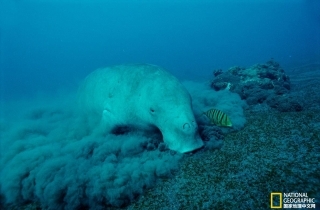According to the National Geographic Chinese website, according to the newly released aeronautical survey (completed in November last year), the entire southern part of the Great Barrier Reef has been covered by a large amount of seaweed. The slow-moving herbivores of dugong, a close relative of manatees, are rising sharply.

In Vanuatu, dugongs feed on seaweed. Photographed: MIKE PARRY, MINDEN PICTURES/NATIONAL GEOGRAPHIC, written by: John Pickrell.
Over the years, we have rarely heard good news about the Great Barrier Reef. However, in this difficult environment, a large animal still has a pleasant life.
This round marine mammal seems to be experiencing baby boomers. The Great Barrier Reef Marine Park Service reported that of the 5500 dugongs counted, 10 percent were young.
The most recent survey was in 2011, when no cubs were found in dugong's favorite food, seaweed, as a result of the storm. Since then, seagrass pastures along the coastline have gradually resumed, and dugongs have grown. Females need plenty of nutritious plants to have children.
"this is good news for this species," said Susan Sobtzick, an estuarine and coastal ecologist at James Cook University. The International Union for Conservation of Nature has listed it as a vulnerable species. The storm harms dugong, one of four species of manatees that live in shallow waters of the Indian Ocean-Pacific Ocean. The world's largest population of dugongs is located in northern Australia and covers vast areas of water from Shark Bay in the west to Morton Bay in the east.
Throughout history, such slow-moving animals are easy to catch for hunters. But today, their biggest threats come from coastal development, the decline in seagrass pastures, and fishing nets and shark nets. These nets are used to protect Australian beach visitors. In 2011, nine months after Hurricane Yashi swept through, "the estimated number of dugongs dropped to the lowest level since the 1986 survey," Sobtzick told us.
At that time, scientists found less than 600 dugongs. 187 stranded on the coast, dead or near death. Massive floods following Hurricane Yashi washed sediment into the ocean, possibly killing seaweed. Mermaid or dugong? Janet Lanyon, a dugong expert at the University of Queensland, did not participate in the new report, adding that "seaweed provides less nutrition and energy, and the dugong needs to eat a lot of seaweed to keep it in shape." "if rainfall and coastal flooding occur frequently, the future of dugongs will be less optimistic," Lanyon said. If climate change leads to more severe weather, the number of dugongs will undoubtedly be affected. "
Experts say a rapidly warming ocean can whiten and kill corals in the Great Barrier Reef, but it is unclear whether it will have a negative impact on dugongs. Tooni Mahto, a veteran marine activist at the Australian Ocean Conservation Society, who celebrates caution in Brisbane, said the rise in the number of dugongs was "well worth celebrating." But she also said we should be cautious. Mahto was not involved in the new report, she said: "the current number of dugongs is only 3 to 5 percent of the historical number." The development of southern Queensland had caused excessive damage to dugongs. Some dugongs were caught in shark nets near the beach and drowned.
"since dugongs do not have many offspring, recovery is slow," Mahto said. So in some parts of the south, the increase in dugongs must be the result of northern migration. So I don't think there's been a significant increase in the number of dugongs in the south, and I don't think there's been an increase in the number of dugongs compared to the previous catastrophic survey season. " The report's authors also agree that the changes in dugongs are linked to their migration in search of seaweed. But it is still good news that the growing number of dugongs has been brought about by the lush plants.